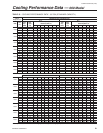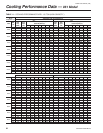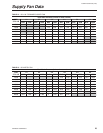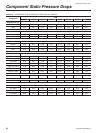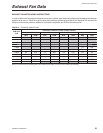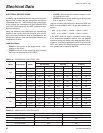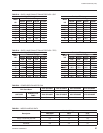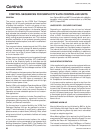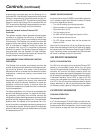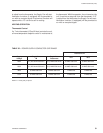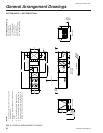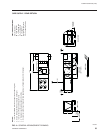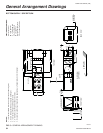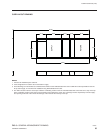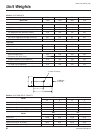
FORM 100.50-EG5 (108)
29
JOHNSON CONTROLS
the Return Air Temperature Setpoint, Morning Warm-
Up ends when occupancy occurs (BAS, Intelli-Start, or
contact closure), or when the Maximum Morning Warm-
Up Time has expired.
ECONOMIZER OPERATION
The unit can be equipped with one of three types of
optional economizers: dry-bulb, single-enthalpy, or com-
parative-enthalpy. When the unit controller determines
that Outside Air is suitable for economizing, the unit
controller will control the outside air damper(s) open
to provide economizer cooling. If economizer cooling
alone is insuffi cient for the cooling load, the unit control-
ler shall stage up compressors, one at a time, to meet
demand.
The control logic for the three types of economizers is
as follows:
Dry-Bulb Economizer
The dry-bulb economizer is the default economizer
control scheme. With the dry-bulb economizer, the unit
controller monitors the Outside Air temperature only
and compares it to a reference temperature setting.
Outside Air is deemed suitable for economizing when
the Outside Air temperature is determined to be less
than the reference temperature setting. This method of
economizing is effective, but is prone to some change-
over ineffi ciencies due to the fact that this method is
based on sensible temperatures only and does not take
Outside Air moisture content into consideration.
Single-Enthalpy Economizer
With the optional, single-enthalpy economizer, the unit
controller monitors the Outside Air enthalpy in addition
to the Outside Air temperature and compares it to a
reference enthalpy setting and a reference temperature
setting. Outside Air is deemed suitable for economizing
when the Outside Air enthalpy is determined to be less
than the reference enthalpy setting and the Outside Air
temperature is less than the reference temperature set-
ting. This method of economizing allows the reference
temperature setting to be set higher than the dry-bulb
Economizer and is a more effi cient packaged rooftop
economizer.
Dual-Enthalpy Economizer
With the optional, dual-enthalpy economizer, the unit
controller monitors and compares the Outside Air and
Return Air enthalpies, in addition to comparing the
Outside Air temperature to the reference temperature
setting. Outside Air is deemed suitable for economizing
when the Outside Air enthalpy is determined to be less
than the Return Air enthalpy and the Outside Air tem-
perature is less than the reference temperature setting.
This method of economizing is the most accurate and
provides the highest degree of energy effi ciency for a
packaged rooftop economizer.
VENTILATION CONTROL SEQUENCES
Minimum OA Damper Position (CV Units)
When the unit goes into the Occupied mode of operation,
the unit controller shall open the Outside Air Damper to
a fi xed minimum position. The damper shall remain at
this position as long as the unit is in the occupied mode,
and the economizer is not suitable for cooling.
Minimum OA Damper Position (VAV Units)
With Variable Air Volume units, there are two Minimum
OA Damper Positions: one when the unit is at full speed
and the second when the unit is at approximately half
speed. These two points allow the control to linearly
reset the position of the OA damper in response to fan
speed.
When the unit goes into the Occupied mode of operation,
the unit controller shall monitor the speed of the supply
fan and open the Outside Air damper to a calculated
minimum position based on the fan speed. This minimum
position shall vary as the speed of the fan changes. The
damper shall remain at this calculated position as long
as the unit is in the occupied mode, and the economizer
is not suitable for cooling.
EXHAUST CONTROL SEQUENCES
Barometric
The optional barometric exhaust system consists of a
lightweight barometric relief damper installed on the end
of the unit in the Return Air section. As more outside air
is introduced into the controlled zone due to Economizer
and Ventilation control sequences, the pressure inside
the building rises. As building static pressure increases
to overcome any exhaust duct static pressure, air will be
allowed to escape through the barometric relief damper.
Because this type of exhaust is not powered, the amount
of air exhausted will be limited to the static pressure that
will need to be overcome.
Powered, Variable-Volume Exhaust-Discharge
Damper Controlled
This optional variable-volume, powered-exhaust system
consists of a fi xed-speed fan confi gured with a propor-
tionally controlled discharge damper. The Rooftop Unit
controller monitors the pressure inside the building and
controls the Exhaust Damper and the Exhaust Fan.
If the Building Pressure rises, the Exhaust Damper is



